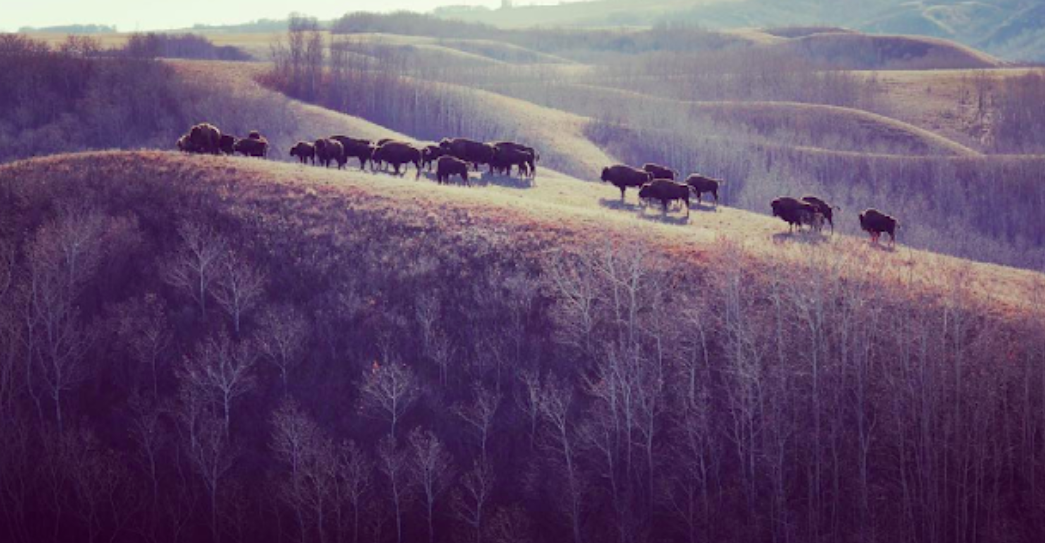Saskatchewan’s Flat Landscape: Our Biodiverse Grasslands

By Caitlyn Anhorn
Fields of golden wheat rustling in the breeze, spread out as far as the eye can see beneath jewel-colored skies: This is a typical view of the Saskatchewan prairies from an outsider’s perspective, and it’s no mystery where that view comes from.
Unfortunately, this limited understanding of the unique and nuanced beauty held within Saskatchewan’s rolling plains is one that diminishes the value of natural prairie ecosystems, and the incredibly diverse micro ecosystems that flourish beneath the surface of the earth.
While Saskatchewan’s prairies were once a thriving wilderness to be reckoned with, roamed by millions of wild plains bison, much of that has been transformed into something unrecognizable from its origins, with less than 18% of the original native grasslands south of the boreal forest remaining.
With such a small amount of Saskatchewan’s irreplaceable native grasslands left, it is crucial to protect these important ecosystems.
Natural VS. Seminatural Grasslands
Natural grasslands are defined in Kenta’s study as, “existing in natural climatic conditions and disturbance systems,” and seminatural as “maintained by artificial disturbances such as pasturing, fire, or mowing.” The problem with this distinction in Canada is that our great rolling prairies were once roamed by plains bison herds whose numbers were in the millions, and the individual species of flora and fauna on these landscapes evolved around the conditions that this keystone species created.
This is why well-managed Saskatchewan grasslands need to be carefully planned to mimic original ecological conditions, using large grazing animals like cattle or domestic bison and completing prescribed burns. Indigenous peoples best know the land and many advocate for these management practices. Also, ranchers are today’s stewards of the grasslands and are increasingly important for grassland conservation and protection.
It is important to note that in today’s prairie habitats within Saskatchewan, seminatural or managed grasslands are often healthier than natural grasslands because grazers like cattle or bison and prescribed burns are needed to promote biodiversity, long-term sustainable growth, and lifecycle renewal of native plant species.

Old growth forests? Move over.
In general, many Saskatchewan grasslands qualify as “old.” A recent study out of Japan (senior author Tanaka Kenta) defines old grasslands as anywhere from 160 to more than 1,000 years old, and new grasslands as having existed for only 52-70 years after deforestation. New grasslands result after some kind of disturbance.
Saskatchewan is unique in its remaining “old” grasslands — though 82% of our original grasslands in Saskatchewan have been lost or destroyed, we have 18% of our province’s prairies remaining that are original native grasslands and date back to the pre-colonization era.
Ancient Grasslands are the Heart of a Healthy Ecosystem
When it comes to biodiversity, healthy ecology, water security, and carbon sequestration, ancient grasslands are at the core.
Results from the study in Japan demonstrate that old grasslands are home to the world’s highest number of plant species; especially native and endangered species. New grasslands have the next highest number of plant species, followed closely by forests.
Overall, old grasslands have higher plant diversity than new ones and are therefore a healthier ecosystem. Kenta’s study also found that old grasslands have considerably more indicator species than new grasslands. It is crucial to protect and keep watch on indicator species, like various grassland birds, because their wellbeing can indicate the health of other species in the ecosystem.
A region’s plant history affects its current state, meaning that “new” grasslands are affected by the plants or other impacts that were there before. Kenta’s study also found that new grasslands never fully recover from deforestation, even after over 50 years. Therefore, if an area goes through deforestation or land-use change before being transformed to “new” grassland, it will be influenced by the previous use and will not be as pristine as old and undisturbed grasslands.
Recovering or rebuilding new grasslands is never going to be as good as protecting old ones.
Preserving old-growth grasslands needs to be a priority in conservation. Old-growth grasslands are home to many unique species that might not otherwise get to live in their ideal conditions. Since Saskatchewan still has 18% of its native grasslands, this is the best time to continue preserving these habitats.
New grasslands, or those that have gone through deforestation or the like, do not house the same number of species and will not recover to their old state within our lifetimes. Why does the number of species matter, you ask? Because with a higher number of diverse species comes a healthier ecosystem and increased benefits for all species on earth, including humans.
It is important to remember that big grazers like bison (or cattle) and prescribed fire are crucial to maintain biodiversity and ecosystem health by mimicking old patterns and resetting grass lifecycles in Saskatchewan. Though these may seem like daunting and unhealthy management practices, they are actually necessary for maintaining a healthy grassland ecosystem for the native grasses and all the species that live there.
Saskatchewan and ECCC’s fairly recent announcement
It’s because old grasslands are home to the world’s highest number of plant species that we’re so excited about the 80,000 hectares of native grassland in the Govenlock, Nashlyn, and Battle Creek Community Pastures that have been recently transferred to Environment and Climate Change Canada for protection.
The three community pastures listed here are home to many species at risk including Swift Fox, Sprague’s Pipit, Chestnut-collared Longspur, McCown’s Longspur, Greater Sage Grouse, Burrowing Owl, Ferruginous Hawk, Mountain Plover, Long-billed Curlew, and Northern Leopard Frog.
In summary, old-growth grasslands and using management practices that mimic natural disturbance are crucial for biodiversity. Let’s protect the old grasslands as one of the few ancient habitats that remain! After all, why do we humans deserve the right to take these homes away from the thousands of other species that also live as part of the ecosystem?
